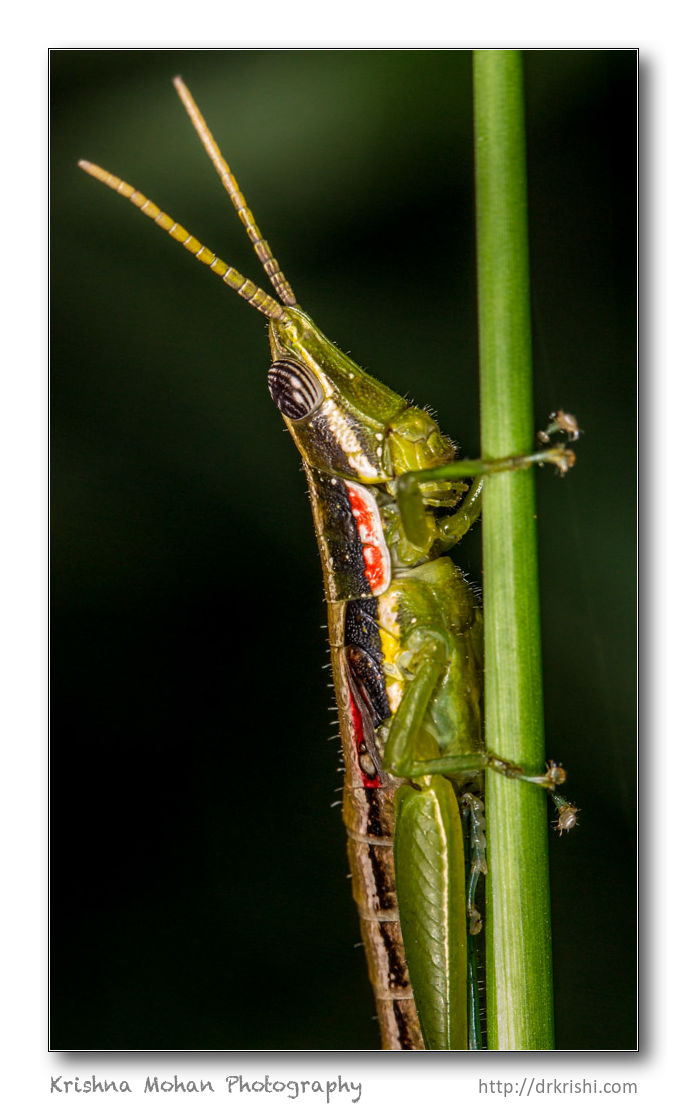
Grasshoppers are herbivorous insects. To distinguish them from bush crickets or katydids, they are sometimes referred to as short-horned grasshoppers. The one here is Short Horned Gaudy Grasshopper Neorthacris simulans. It belongs to Pyrgomorphidae family of grasshoppers in the order Orthoptera commonly known as the gaudy grasshoppers. They are short horned, flightless grasshoppers. Pyrgomorphoidea, and contains 29 genera and at least 70 species and subspecies. They do not develop wings and are flightless.
I used Canon EF 100mm f/2.8L Macro IS USM with full set of Kenko extension tube set on my Canon EOS 5D Mark III. The illumination was by using Canon MT-24EX macro twin light flash which you can see in the eye of the grasshopper. I used a white plastic (half of the plastic container which is used as food packing) as diffuser to reduce the glare from the shiny body of this grasshopper.
Grasshoppers are medium to large insects. Adult length is 1 to 7 centimetres, depending on the species. Like their relatives the ‘katydids’ and ‘crickets’, they have chewing mouth parts, two pairs of wings, one narrow and tough, the other wide and flexible, and long hind legs for jumping. They are different from these groups in having short antennae that do not reach very far back on their bodies. Grasshoppers do not actually ‘jump’. What they do is use their legs as a catapult. Grasshoppers can both jump and fly (those with wings) and they can reach a speed of 8 miles per hour when flying.

Grasshoppers usually have large eyes, and are coloured to blend into their environment, usually a combination of brown, grey or green. In some species the males have bright colours on their wings that they use to attract females. A few species eat toxic plants, and keep the toxins in their bodies for protection. They are brightly coloured to warn predators that they taste bad.
Female grasshoppers are larger than the males and have sharp points at the end of their abdomen that are there to help them lay eggs underground. Male grasshoppers sometimes have special structures on their wings that they rub their hind legs on or rub together to make sounds. Grasshoppers can be found almost everywhere in the world, except for the colder regions near the North and South poles.
Grasshoppers live in fields, meadows and just about anywhere they can find generous amounts of food to eat. A grasshopper has a hard shell and a full grown grasshopper is about one and a half inches, being so small you would not think they would eat much – but you would be so wrong – they eat lots and lots – an average grasshopper can eat 16 time its own weight.

The grasshopper’s favourite foods are grasses, leaves and cereal crops. One particular grasshopper – the Shorthorn grasshopper only eats plants, but it can go berserk and eat every plant in sight – makes you wander where they put it all.
Grasshoppers are most active during the day, but also feed at night. They do not have nests or territories and some species go on long migrations to find new supplies of food. Most species are solitary and only come together to mate, but the migratory species sometimes gather in huge groups of millions or even billions of individuals.
When a grasshopper is picked up, they ‘spit’ a brown liquid which is known as ‘tobacco juice’. Some scientists believe that this liquid may protect grasshoppers from attacks by insects such as ants and other predators – they ‘spit’ the liquid at them then catapult up and fly off quickly.
Grasshoppers also try to escape from their enemies hiding in the grass or among leaves. If you have ever tried to catch grasshoppers in a field, you know how quickly they can disappear by dropping down into the tall grass.

The grasshopper’s greatest enemies include various kinds of flies that lay their eggs in or near grasshopper eggs. After the fly eggs hatch, the new-born flies eat the grasshopper eggs. Some flies will even lay their eggs on the grasshopper’s body, even while the grasshopper is flying. The new-born flies then eat the grasshopper. Other enemies of grasshoppers include beetles, birds, mice, snakes and spiders.


Nice documentation Sir.